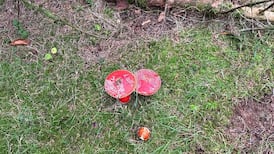ANOTHER LIFE: THE POT HELD a primrose plant in full flower and violets blooming in green moss. It hardly needed the "Get well soon" message: this sang out from the springing leaves and petals, the living hedge bank fragrance.
The pot stayed near me, on the bed tray. It made every nurse smile – they are good at it anyway – and did wonders for my little red cells. I have had bigger, more exotic bouquets on these occasions, but this was special.
A variety of medical misadventures over the years – much ameliorated, happily, by plenty of fresh air and fibre, and the perennial promise of the good life – has made me something of a student of hospital horticulture.
In my adopted Mayo, I am proud to report, Castlebar Regional has a splendid scented garden in a sheltered quadrangle, full of herbs and shrubby flowers. On first acquaintance, the mosaic of fag ends stubbed out in the raised beds was depressing, but No Smoking signs have improved that no end.
In Galway, living planthood is mostly confined to well-watered pots in the X-ray waiting room – a good try – and the atrium is distinguished by its lofty frieze of plastic bamboos. I brooded on the floral potential of the concrete quads, one occupied daily by a solitary Rolls-Royce – if this was my man’s, he’s well worth it, no question – and listed shrubs in my mind that do well in the shade.
The Mater in Dublin may be good for the heart, but I cannot recall one therapeutic leaf there: my lovely bouquet of freesias had to do for the whole public ward. Otherwise, acres of asphalt roof with puddles and the odd lonely seagull filled day after day.
When the pictures of the proposed national children’s hospital were published, it was not the height or the bulk of the building that first caught my eye but the glorious, ascending terraces of greenery.
The huge benefits to health of even passive enjoyment of growing plants and gardens is undeniable. It goes far beyond mere aesthetic pleasure (though all positive feelings have value where one is sick). It is part of the strong affinity people have with the rest of the natural world: biophilia, as the theorists call it. The fact that people prefer to look at trees and flowering plants and find them wonderfully calming is backed up by clinical studies of the effects this has on blood pressure, muscle tension and even awareness of pain.
There is growing global support for therapeutic horticulture – “healing gardens” sounds better – and to find it so well recognised in the design of the new children’s hospital was welcome but no great surprise.
Beyond the benefits of views of living greenery for children sick in bed is the great value of leafy, restful spaces for convalescence, play and the visits of families with restless squads of Sunday-afternoon siblings.
A closer look at the plans for the hospital’s roof gardens and “therapy park” finds great technical ingenuity by the landscape architects Dermot Foley and Remi Salles. Sheltered and intimate green spaces abound, with pergolas, a maze, a graffiti wall, a corner with a hammock and another with a telescope. The dominance of low-maintenance, wind-resistant bamboos and birches is, perhaps, inevitable, but a wild-flower meadow planned for level 5, laced with bloody cranesbill, might do something to make up for it.
But how many children in the 400 or so beds are destined to catch even a glimpse of this greenery? Would any of this seem “grandiose” to Minister for Health James Reilly? One has to hope not. How much green space would be lost in compressing the hospital’s bulk and height? Far better, surely, to let it all breathe, blossom and blend with nature on the offered greenfield site.
Meanwhile, the new anxiety over hospital-bred infections such as MRSA is banishing flowers even from the bedside. Some hospitals in the UK have already barred bouquets from high-risk areas of intensive care. St Vincent’s in Dublin goes further. “In the interest of patient safety, hygiene and comfort,” runs its prissily-worded injunction, “we ask that you do not bring flowers into the hospital. If you receive flowers, please send them home with a family member or friend.”
In response, I would offer a paper in the Journal of Infection Prevention by medics from St Bartholomew’s School of Nursing and Midwifery at City University in London. “Occasionally,” it concludes, “new practices become part of clinical routines despite the lack of supporting evidence. Banning flowers from general hospital wards falls into this category.
“Although the water in which flowers stand can become a reservoir of potentially pathogenic bacteria, there is no evidence that they have ever caused hospital-acquired infections and simple precautions can be taken to reduce . . . risks. Banning flowers from general wards is not popular with the public and is unnecessary according to the evidence available.”
Not to mention the comfort one patient got from a primrose in a pot.
Eye on nature
A great glory of nature here in winter is the arrival of a vast, swirling flock of knot descending to feed on the extensive mudflats. Where are the birds when the tide is in, and what they are doing?- Robert B Hayes, Baltray, Co Louth
When the tide is in, waders retire to roosts where they apparently sleep. Roosts are carefully chosen and are a necessary adjunct to the feeding areas. They must be fairly open, so predators can be detected, not too dry and close to the feeding grounds, to save energy getting there.
I saw two beautiful rustic buntings on rocks at the end of Howth fishing pier on March 8th.- Jennifer Rickard, Sutton, Dublin 13
Rustic buntings are very rare vagrants from Scandinavia in winter and sometimes in spring, when they are seen on coastal headlands and islands.
On March 4th I saw a black redstart in my garden. Is it unusual to find them in Ireland? -Pat O'Driscoll, Tramore, Co Waterford
They are regular passage migrants in spring in coastal areas.
Why is dead ash wood sometimes very hard and at other times decays much more quickly?- Val Keogh, Feacle, Co Roscommon
Faster decay can be due to fungal activity.
* Michael Viney welcomes observations at Thallabawn, Carrowniskey PO, Westport, Co Mayo, or email viney@anu.ie. Please include a postal address










